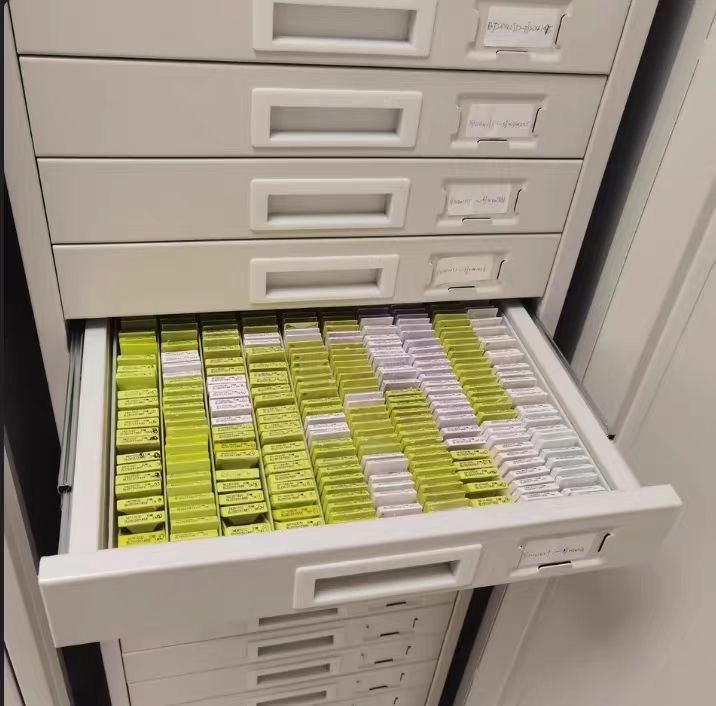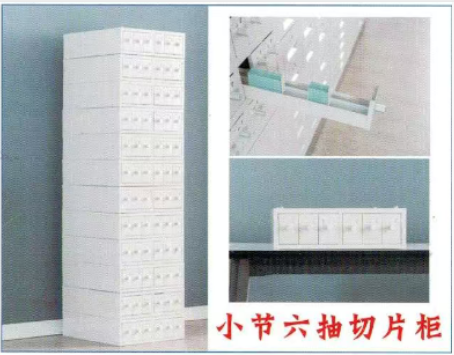Toronto Pathology Storage Cabinet Buying Parameters: Wax Blocks & Slides
In the dynamic field of pathology in Toronto, choosing the right storage cabinets for wax blocks, slides, and related specimens is a crucial decision. This blog post aims to provide you with an in – depth analysis of the key parameters to consider when purchasing pathology wax block and slide cabinets, including slide storage cabinets, tissue wax block cabinets, wax block and slide cabinets, and slide drying storage cabinets. These parameters will ensure that you invest in storage solutions that meet the high – standard requirements of your pathology laboratory.

Wax Block Cabinet Parameters
- Material and Finish
- Steel Quality: The wax block cabinet is crafted from 0.8mm Baosteel cold – rolled steel plate. Baosteel is renowned for its high – quality steel, which offers excellent strength and durability. This thickness of steel provides the necessary robustness to withstand the rigors of daily use in a pathology laboratory, ensuring that the cabinet can hold a large number of wax blocks without deformation.
- Anti – rust Treatment: The cabinet undergoes a comprehensive anti – rust treatment. This is essential as pathology laboratories may have a relatively humid environment, and rust can not only damage the cabinet but also pose a risk to the specimens stored inside. The anti – rust treatment safeguards the integrity of the cabinet over an extended period.
- Surface Coating: The electrostatic powder coating process gives the cabinet a matte – white finish. The matte – white color not only provides a clean and professional appearance but also has practical benefits. It is easy to clean, which is vital in a laboratory setting where maintaining a hygienic environment is crucial. Additionally, the powder coating offers protection against scratches and chemical corrosion.
- Drawer Mechanics
- Pulley System: The use of channel – type pulleys, combined with high – strength pulleys at the starting point, ensures smooth and effortless drawer operation. This system allows for easy access to the wax blocks stored in the drawers. The smooth movement of the drawers is not only convenient for the laboratory staff but also helps in preventing damage to the wax blocks during retrieval.
- Auto – return Feature: The drawers are designed to automatically return to their original positions. This feature is extremely useful as it helps in maintaining the order of the storage area. After use, the drawers will close neatly, reducing the risk of accidental damage to the wax blocks due to open drawers.
- Inter – changeability: The fact that different drawers are interchangeable with the cabinet body provides great flexibility. In case a drawer gets damaged, it can be easily replaced with any other drawer, minimizing downtime and repair costs.
- Shock – absorbing Pads: High – strength shock – absorbing pads are installed to reduce the impact when the drawers are closed. This not only helps in reducing noise levels in the laboratory but also protects the cabinet from wear and tear caused by repeated collisions. It also safeguards the wax blocks from potential damage due to sudden impacts.
- Size and Capacity
- Single – section Dimensions: Each single – section of the wax block cabinet has dimensions of 360mm in height, 515mm in width, and 480mm in depth. These dimensions are carefully calculated to optimize the storage space. The height of 360mm is sufficient to accommodate standard – sized wax blocks, while the width and depth allow for efficient arrangement of the wax blocks within the drawers.

-
- Single – section Capacity: A single – section with 5 drawers can store approximately 4000 wax blocks. This high – capacity design makes it suitable for medium – sized pathology laboratories or departments that handle a significant number of specimens on a regular basis.
- Whole – set Dimensions: The whole – set wax block cabinet, including the base, has dimensions of 1520mm in height, 515mm in width, and 480mm in depth. This overall size is designed to fit well in most laboratory spaces while providing a large storage capacity.
- Whole – set Capacity: With a total of 20 drawers, the whole – set cabinet can store approximately 16000 wax blocks. This makes it an ideal choice for larger pathology facilities in Toronto that require extensive storage for their wax block collections.
Slide Storage Cabinet Considerations
- Adaptability to Slide Storage
- While the wax block cabinet parameters are well – defined, the slide storage cabinet should also be considered. It may need to have adjustable interior components to accommodate different sizes and types of slides. For example, some slides may be larger for special pathological examinations, and the cabinet should be able to store them securely.
- The material of the slide storage cabinet should also be of high quality to protect the slides from damage. Similar to the wax block cabinet, it may benefit from anti – rust treatment and a smooth, easy – to – clean finish.
- Slide – specific Features
- Slide storage cabinets may require features such as anti – static lining to prevent dust from adhering to the slides. Additionally, they may have dividers or holders to keep the slides in an upright position, reducing the risk of breakage.
Tissue Wax Block Cabinet Parameters
- Similarities to Wax Block Cabinet
- The tissue wax block cabinet shares many of the parameters of the wax block cabinet. It should also be made of 0.8mm Baosteel cold – rolled steel plate for strength and durability. The anti – rust treatment and electrostatic powder coating are equally important to ensure the long – term protection of the tissue wax blocks.
- Tissue – specific Considerations
- However, tissue wax blocks may require a more controlled environment. The cabinet may need to have better insulation properties to maintain a stable temperature and humidity level, especially if the tissue wax blocks are to be stored for an extended period.
Wax Block and Slide Cabinet Parameters

- Combined Storage Requirements
- A wax block and slide cabinet, if you choose to have a single unit for both, should be designed to meet the storage needs of both wax blocks and slides. It should have a combination of drawers suitable for wax block storage and compartments or holders for slide storage.
- The dimensions of the cabinet should be carefully considered to ensure that it can accommodate a sufficient number of both wax blocks and slides without overcrowding.
- Accessibility and Organization
- Easy access to both wax blocks and slides is crucial. The cabinet should be designed in a way that allows laboratory staff to quickly retrieve the required specimens. Clear labeling and organization of the drawers and compartments can significantly improve the efficiency of specimen retrieval.
Slide Drying Storage Cabinet Parameters
- Ventilation and Airflow
- The slide drying storage cabinet should have a proper ventilation system to ensure that the slides dry evenly and quickly. Adequate airflow helps in preventing the growth of mold and mildew on the slides.
- The ventilation system should be designed in such a way that it does not cause excessive dust to enter the cabinet, which could contaminate the slides.
- Slide – drying Features
- It may have angled shelves or holders to allow the slides to dry in a proper position. Some cabinets may also have temperature – control features to optimize the drying process, especially for slides that are sensitive to temperature changes.

Conclusion
When purchasing pathology wax block and slide cabinets in Toronto, it is essential to consider these parameters carefully. By choosing cabinets that meet these high – standard requirements, you can ensure the safe and efficient storage of your pathology specimens. Whether you are a small – scale pathology laboratory or a large – scale research facility, investing in the right storage cabinets will contribute to the smooth operation of your laboratory and the long – term preservation of your valuable specimens.
Remember, making an informed decision based on these parameters will not only improve the functionality of your laboratory but also enhance the quality of your pathological research and diagnoses.
